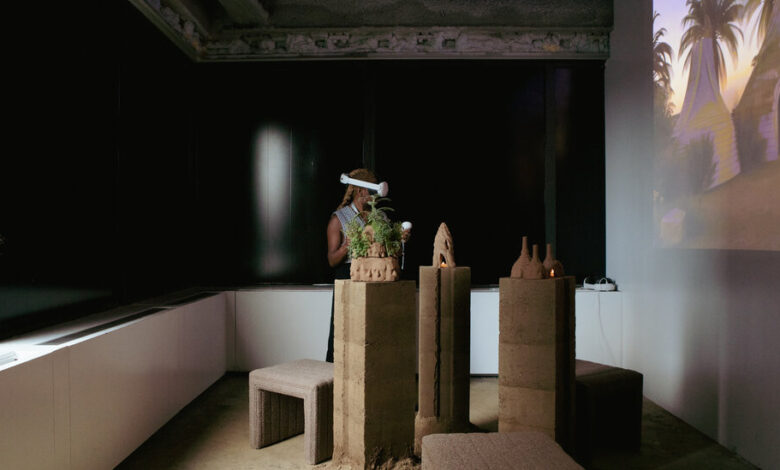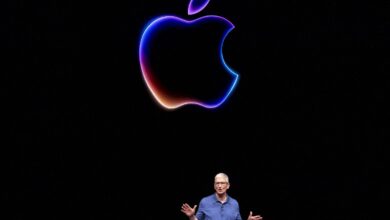Watching the Future Hatch in the New Museum Incubator

Nicole Yi Messier and Victoria Manganiello would like you to talk to their textile. Just pick up the phone and tell it a story. Nothing elaborate — a simple story will do. The textile in question is a few feet away, 18 fabric panels suspended from the ceiling. While you’re talking, ChatGPT will decode the emotions, which are then displayed as colors on fiber optics running through the fabric. The system is constantly evolving, but depending on the circumstances, red could mean joy, blue might mean frustration, purple could signal sadness.
“Ancient Futures,” as it’s called, is one of 33 installations on view through June 20 at 161 Water Street, a Financial District office tower that’s been recently reborn as a collaborative work space and culture hang. All were created by soon-to-graduate members of New Inc, a “cultural incubator” that’s run by the New Museum and will move into the starkly angular addition designed by Rem Koolhaas’s firm, OMA, next year.
Participants in the yearlong program pay as much as $150 per month to be part of an art/tech community — New Inc is very big on community — that includes mentors and alumni as well as staff and fellow participants. What they get in return has more to do with career guidance than with making art.
Art is what’s on view at Demo2024, New Inc’s latest annual showcase of its members’ work. This is where Messier and Manganiello, who work together in a studio called Craftwork in Clinton Hill, Brooklyn, show what they can do with cloth and electronics — materials that suggest physical and digital, fuzzy and hard-edge, past and future. Just down the corridor, Dan Gorelick has set up a listening station where you can hear live air traffic control chatter from Tokyo, New York, Mexico City or Zurich, Switzerland superimposed on algorithmically generated soundscapes — dark and moody compositions punctuated by a highly technical patois.
Around the corner, the Mexico City-born artist and VR developer Alfredo Salazar-Caro is showing 3-D-printed maquettes made of clay — prototypes for fantastical houses that might be constructed simply by pressing “print.” And the architectural designer Jeremy Schipper critiques the gentrification of the East Village with an elaborate maquette surrounding the 1888 Temperance Fountain in Tompkins Square Park. But at New Inc itself, the focus is less on making art than on making it in a way that provides a living for the artist.
“I think the days of, like, starving artists are gone,” New Inc’s director, 34-year-old Salome Asega, said with a laugh. “The rent is due!”
Craftwork’s experience is typical. “Ancient Futures” was developed with support from CultureHub, a joint program of La MaMa ETC, the Lower Manhattan theater company, and the Seoul Institute of the Arts. Messier and Manganiello joined New Inc the following year.
“We came in with a lot of uncertainty as to what we wanted to get out of it,” Manganiello admitted. That began to change when they were matched with their mentor, James Rohrbach, a partner at the real estate firm Alchemy Ventures and an artist. The three met once a month to map out a business plan, a budget and a communications strategy. “There’s this myth that the art world perpetuates of lonely visionaries in the studio by themselves,” said Manganiello. “But things are often more interesting when many minds are involved.”
By the end of this year, New Inc will have graduated 653 people and helped create or sustain 324 businesses since it was formed a decade ago, the brainchild of the New Museum director Lisa Phillips and then-deputy director Karen Wong. It takes its cue from the tech industry, which for the better part of 20 years has had incubators for nascent businesses and accelerators for those that are past the idea-scribbled-on-a-napkin phase. Gone are the days of two geniuses in a garage; companies like Airbnb and Dropbox got their start in a cocoon of know-how — mentorship, partnerships, entrepreneurship, fund-raising — spun by outfits like Y Combinator, Techstars and Betaworks. New Inc offers a similar embrace to tech-focused artists and designers.
As with tech incubators, the goal is to help people develop a sustainable business model. Applicants are told that at a minimum they should come out with basic tools for success: a plan, a purpose, a pitch deck, a mission statement, a website, a way to make money. These are not things you get from an M.F.A. program, where the focus is on making art.
New Inc bills itself as the first cultural incubator to be led by a museum, but it isn’t the only such initiative. MIT has an Arts Startup Incubator; cities like New Orleans and Chicago and even Fargo, N.D., have arts incubators as well, usually as part of some economic development program. And there are a number of individuals who have set themselves up as online art coaches. But few if any of these programs operate on the scale of New Inc, which spent nearly $1.7 million in its most recent fiscal year.
Two years ago, New Inc got a boost from the Mellon Foundation — a three-year, $1.5 million grant in support of, as the foundation’s website put it, “Salome Asega’s vision.” A first-generation Ethiopian American who grew up in Las Vegas, Asega had been named New Inc’s director in 2021 after four years as a technology fellow at the Ford Foundation — where she was hired by the poet Elizabeth Alexander, who became head of the Mellon Foundation soon after. The vision Mellon is supporting includes the three-day Demo festival, previously a one-day affair. But ultimately, Asega’s vision involves “reworlding,” as she calls it— “to reimagine, to re-envision, to reworld. Which I think is beautiful, because it’s thinking about things at a structural level.”
“She really looks at what she does as social sculpture, using the community as a medium,” Karen Wong said.
Asega has also secured grants and partnerships from the Simons Foundation, which supports efforts in mathematics and basic science, the Robert Wood Johnson Foundation and the global consulting firm EY and its Metaverse Lab. Her predecessor, Stephanie Pereira, partnered with the Onassis Foundation to create Onassis ONX, an art accelerator with a sophisticated digital studio, free for artists to use, in Olympic Tower on Fifth Avenue.
All this has made New Inc attractive not just to fledgling artists and designers but also to those who are well-established. One of this year’s members is Lauren Lee McCarthy, a professor of Design Media Arts at the University of California, Los Angeles, whose “saliva bar” at Demo encourages people to leave some spit in a little tube and maybe go home with a stranger’s.
“It started out as this sort of absurd idea,” McCarthy said, “but it becomes this lubricant almost for talking about things like bodily autonomy and data privacy. So a big part of it is people negotiating, like, what can and can’t be done with your saliva? Could it be used for weapons? Could it be used for tracing DNA or making a clone?”
McCarthy credits New Inc with helping her develop the saliva project, but the main reason she signed on was to learn how to run a lab she’s starting with a colleague at U.C.L.A. “Just like, how do you think about the legal aspects or the financial aspects or the fund-raising or the outreach or all these different parts of your practice? New Inc did a really good job of supporting all of those.”
New Inc has also done well by artists who were less established when they came in. The multimedia artist Rachel Rossin was commissioned to do an installation at the Whitney Museum of American Art in 2022 and had another at a recent fund-raiser for the Solomon R. Guggenheim Museum. John Fitzgerald and Matthew Niederhauser work as innovation director and technical director, respectively, at Onassis ONX and co-founded Sensorium, an extended reality studio whose credits include a dramatization of the George Saunders novel “Lincoln in the Bardo” for The New York Times Magazine. Stephanie Dinkins parlayed her inquiries into bias in artificial intelligence into a $100,000 grant from LG and the Guggenheim Foundation and a role in former Google chief executive Eric Schmidt’s $125 million initiative with his wife, Wendy, to make sure AI benefits society.
“I think art is a really interesting and magical space,” said Dinkins, “that allows us to think freely. Like playing in the A.I. space without a full knowledge of A.I., which allows me to ask a two-year-old’s questions” — questions that are the tech-world equivalent of why is the sky blue?
At a time when reality is reshaped on a regular basis by in-your-face billionaires whose claim to humanity can seem dubious, this kind of thing can offer a corrective. “It can help us keep these technologies human-centered, so technology is working for us and we’re not working for technology,” said John Borthwick, managing partner of the New York tech accelerator Betaworks.
A one-time digital content pioneer who now sits on the board of Rhizome, Borthwick tells a story about going to Jenny Holzer with a very early art-and-technology site he’d helped create. This was in 1994. Internet speeds were painfully slow. Borthwick was strategic: “The reason I chose Jenny was text, right?” Holzer’s response was blunt: “I have no idea what the [expletive] you’re talking about, but if you’re in New York you can show me your internet and I’ll cook you some chili.”
It’s very New York, this kind of cross-cultural exchange, reminiscent of the Bell Labs engineer Billy Kluver working with Robert Rauschenberg in the 1960s. Then it was the pocket-protector set consorting with big-name artists; now it’s artists learning technology so they can speak the language of A.I. and data harvesting and digital surveillance and maybe help find the narrow, half-hidden path that leads to those unparalleled rewards we’ve been promised and not to dystopia.
“San Francisco is very good at building tech companies,” Borthwick said. “In New York, we have a different way of doing things.”



